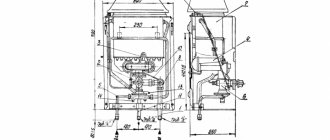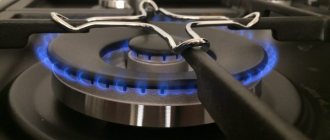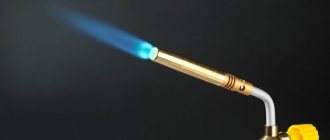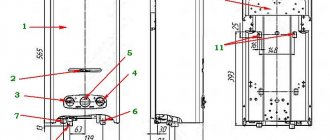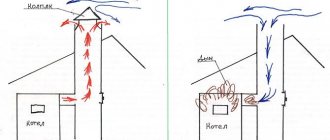Instantaneous gas water heaters are a traditional attribute of old housing stock. This type of equipment is little known to owners of apartments in high-rise buildings with centralized hot water supply. However, the owners of Khrushchev buildings still actively exploit it. Not all of them know how to install a gas water heater in an apartment.
Agree, this issue needs a thorough analysis. Illiterate installation of a gas processing unit will result in a serious threat. The information contained in our very useful article will help you eliminate the slightest risks. We will introduce you to all the intricacies and details of the installation process.
The carefully verified and systematized information we present is supported by photo collections and videos. With us you will receive complete answers to all possible questions that arise when connecting gas units.
If the column has already been installed before
When changing a water heater in case of malfunction, the device passport must also be replaced. If you install a gas water heater yourself, then the passport of the new device will not contain notes on commissioning and inspections.
According to fire safety requirements, gas equipment in homes must be inspected annually. Unauthorized replacement of a water heater will not go unnoticed and most likely the device will be turned off and sealed
After receiving the comment, it will be necessary to reconnect the column, inviting certified specialists.
Their responsibilities include inspecting the ventilation system. In older homes, they may become clogged with debris. It is dangerous to operate clogged ventilation ducts. This can cause carbon monoxide poisoning, which can be fatal. If the decision to install the water heater yourself is made, then first of all you need to check the ventilation.
Setup and launch
Before starting any gas equipment, the integrity of the supply lines is first checked. These are primarily seams, joints and joints. The water pipeline should not leak, and the gas pipeline should not allow gas to pass through. If the malfunction of the first is immediately noticeable, then a special method must be used to check the second. Its essence is as follows:
- All inspection points are lubricated with soapy water.
- Next, the gas valve opens.
- A visual inspection of problem areas is carried out.
If soap bubbles appear and grow, it means that the connections are not tight and require replacement or repair.
When the leak test is completed and the detected faults are eliminated, the gas water heater is configured. The procedure is carried out strictly according to the instructions by the masters. They must carry out the first startup and balance the pressure in the system using a pressure gauge.
Requirements for a room with gas equipment
The place where the gas water heater will be installed must have a cubic capacity of more than 7.5 m3. The height in the room should not be lower than 2.0 meters. According to the standards, this height is sufficient for a gas water heater. The room must have glazing.
The window cannot be solid; it must be possible to ventilate in case of leakage. The total glazing area (without frame) is determined by the formula:
C=O*0.03,
Where:
C is the glazing area. O is the volume of air in the room.
The window must allow air to pass through for emergency ventilation. An ordinary kitchen fully meets these requirements if it is equipped with a door. If there is no door in the kitchen, then it must be installed.
Approximate layout of the column, taking into account fire standards. The door must have at least 0.8 m square meters of closed area without glazing
It is advisable to install a gas analyzer in the room. It will help detect gas leaks. This device is optional, but helps monitor the operation of gas appliances. It reacts to excess propane in the air, and then warns about it with a signal.
Image gallery
Photo from
Location of the gas water heater
Standardized minimum ceiling height
Availability of ventilation devices
Ventilation gap in the used room
Cost of installing a geyser
Here is the average price level for different types of work:
- dismantling the old column: 250 rub. (if she was not disconnected from communications, you will have to pay another 900 rubles);
- installation of a new speaker (with connection): RUB 1,900;
- installation of a gas tap: 100 rubles;
- attaching the flange to the chimney: RUB 350;
- chimney installation: the price of the work depends on the length, the minimum is 800 rubles;
- additional payment for independent purchase of materials by the master: 500 rubles;
- speaker setup: 1200 rub.
If there is a need for any additional work, it will be paid for as agreed.
Thus, connecting a speaker costs an average of 4,500 rubles. (cost of materials is not included here).
An increase in the cost of work occurs under the following circumstances:
- If the master had to purchase additional materials in the store.
- If necessary, lay pipes longer than 1 m (regarded as a separate type of work).
- If you had to change the old chimney pipe from the connection point of the column to the chimney.
- If the root valve on the water pipe is leaking.
- If necessary, replace the existing gas valve.
- When the object is located at a significant distance (outside the city limits).
Usually one working day is enough to complete a set of works.
For an additional fee, the column can be installed a few hours after completing the application or the next day.
Requirements for ventilation and chimney
To create air circulation in the room, a ventilation hole is necessary. It should not be clogged, air should pass through it calmly. If you neglect this rule, then in the event of a gas leak, the residents of the apartment will receive poisoning with serious consequences.
The risk of household gas detonation will increase significantly if it is not removed naturally, since a leak can occur at night, when a person is not able to detect it.
For the normal functioning of the gas water heater, an additional chimney must be installed. It can be brought into the common house system or directly onto the street. When constructing a chimney, it must be taken into account that it cannot have more than two bends at an angle of 90 degrees.
The total length of the chimney should not exceed three meters. Three options for the location of the chimney pipe are allowed.
Its location is determined by the location of the water heater. Pipes for removing combustion products must be made of non-combustible materials. It is worth giving preference to chimneys with the lowest thermal conductivity (+)
The pipe must have a vertical section at the point of connection to the water heater. The length of the vertical section must be greater than or equal to 50 cm. The length of the horizontal section of the pipe should not exceed two meters.
It is possible to make a chimney from a flexible corrugated pipe, but it is necessary to prevent its sagging, which can block the removal of combustion products.
The diagram describes in detail how you can and cannot install a chimney in an apartment. In addition to the length of the pipes, there are requirements for their slope. For each meter it is necessary to observe a two-degree slope (+)
If the installation of the column does not involve a chimney, then you cannot limit yourself to a ventilation hole in the wall. It is necessary to install a full-fledged hood, but even in this case, the gas service will have questions about such a carbon monoxide removal system.
Image gallery
Photo from
Smoke exhaust from a gas water heater
Corrugated pipe for chimney
Construction of a gas outlet from polymer corrugation
Chimney made of rigid pipes and bends
When to install
Installation of gas-fired water heating equipment in an apartment is usually carried out in the following cases:
- To heat water in the absence of hot water supply or when it is turned off for a long time for various reasons, a new gas water heater is purchased for this purpose.
- When changing the location of the speaker, move it to another room from a place not intended for its placement according to regulations.
- When purchasing new water heating equipment to replace the old one and installing it in the appropriate room without carrying out a large amount of installation work.
Rice. 2. Diagram of a column with piezo ignition
Installation of a chimney in an apartment with wooden walls
In wooden houses, the use of a blue fuel water heater is allowed, but fire safety standards for installing a gas water heater must be observed. The chimney cannot come into contact with wood; non-combustible material must be placed between them.
Basalt or mineral wool can be used as thermal insulation. It is allowed to use heat-resistant polyurethane foam.
This is necessary to prevent fire in the event of strong heating of the chimney. As a rule, old wooden houses do not have chimneys, or they are intended for stove heating. It is prohibited to install gas equipment in unsafe houses.
Image gallery
Photo from
Correct installation on a wooden surface
Violation of speaker installation rules
Protective apron made of ceramic tiles
Features of the use of thermal insulation
Video description
Video example of installing a gas water heater:
Next, a separate branch is laid from it to the unit. There are two possible ways to connect a gas water heater to a gas pipeline:
- Precise pipe delivery directly to the connection point. In this case, the device is first installed, and then a gas pipeline is connected to it. This eliminates the need for a flexible hose. The downside is complete dependence on the work schedule of specialists.
- The approximate pipe connection is 0.5 m before the installation site of the unit. It is permissible to first install the pipeline and then install the column more freely. In this case, for the final connection you will have to use a short flexible pipe. The method allows you to install equipment at any suitable time - regardless of the work hours of the craftsmen.
Upon completion of the procedure, the water heater is connected to a water source. For this purpose, a distributor tee is cut into the cold water supply, from which a separate pipe is led to the heat exchanger. Installation can be done in two ways:
- By bringing the pipe 0.3 m to the unit, and then connecting it with a flexible hose.
- Direct connection using copper, steel or metal-plastic pipes.
Column layout rules
The water heater cannot be located on a load-bearing wall of the building. This is directly prohibited by the requirements for the installation of geysers. In the event of an explosion, this may result in damage to the building or its partial destruction.
To clarify the possibility of installing the device, you need to take information from the cadastral passport of the apartment and the general plan of the house. This information can be clarified by calling specialists.
There are requirements for the space from the column itself to the opposite wall. The distance should not be less than one meter. This is necessary for free access to the device for its maintenance and inspection. It is also forbidden to install gas supply pipes into the walls.
This makes it difficult to inspect communications and find gas leaks in the apartment. If this violation is detected, an order to eliminate it will be issued and information will be provided on how to correctly install the gas water heater and where to contact.
The wall where the speaker is planned to be installed must be prepared accordingly. Combustible materials such as wallpaper and PVC panels must be removed from it.
The column must be located at a distance of more than 10 cm from the wall. It is not allowed to install a gas water heater on a wooden wall without prior preparation. A steel plate must be installed at the installation site, equal to or larger in area than the back wall of the device.
It is not allowed to install a column above a gas stove. These devices must be at least 1 meter apart from each other. Also, you cannot use the hood for a gas stove as a exhaust outlet for combustion products. You cannot use one chimney for the hood and gas water heater. This is expressly prohibited by safety regulations.
Image gallery
Photo from
Distance standards from the sink
Distance between the stove and the gas water heater
Shut-off valves on the gas supply pipe
Mixer location specifics
Installation of equipment
The sequence of actions when installing a column usually looks like this:
- Markings are applied to the wall: holes will be made along it. The column should be located at a sufficient distance from the stove and at such a height that the viewing window is exactly at the user’s eye level. The length of the vertical section of the chimney extending from the column must be 500 mm or more if the ceiling height is 2 meters or more, and not less than 250 mm if the distance from the ceiling to the floor is equal to or greater than 2.7 meters. You should also take into account the requirements of the standards discussed above.
- Having drilled the holes, insert the dowel sleeves into them, and then screw in the mounting hooks onto which the column is hung.
- A tee with a ball valve and a filter is cut into the cold water pipeline, which is connected by a pipe or hose to the inlet fitting of the water circuit of the column. With a collector circuit, the pipe is laid from the collector pipe, and a ball valve and filter are installed on it. Please note that the inlet and outlet fittings are not equivalent - it is important to identify the inlet one. If a steel pipe is used for connection, the threaded connections must be sealed with tow, flax, FUM tape or Tangit Unilok thread. When using a hose (flexible line), there is no need to use a sealant - the tip of this element is already equipped with a gasket.
- In a similar way, a pipe for distributing hot water is connected to the outlet fitting.
- Next, you should smoothly open the root valve on the cold water pipeline. In this case, you need to monitor whether leaks appear at the joints. If it appears, you need to tighten the nuts (for the flexible line) or add a sealant.
- The gas fitting of the column and the tap on the gas supply line are connected by a hose, which must be clamped with clamps. The tightness of the connections is checked using soap foam - if there are leaks, it begins to bubble.
All that remains is to secure the pipe to the smoke exhaust pipe and install the draft sensor according to the instructions. The second end of the pipe is inserted into the chimney channel using a special adapter. Now you can carry out a test run.
If you want to replace an old speaker, you shouldn't buy the first one you come across. Modern devices have many functions that can be useful. How to choose a geyser for organizing autonomous hot water supply, read on.
How to choose a deep-well pump for a well and how much the equipment costs on average, see this review.
When designing water supply systems, it is necessary to select the correct pipe parameters. Here https://aquacomm.ru/vodosnabzenie/zagorodnyie-doma-v/avtonomnoe-vodosnabzhenie/trubyi/stalnyie/tablica-diametroy.html tables of steel pipe diameters, their weight, material and thickness are given.
Specifics of gas supply installation
The pipes in the apartment are the property of its owner, but unauthorized changes to the gas supply system cannot be made. For any changes, you must obtain permission from the gas service, otherwise a fine will be issued.
If the gas water heater has already been installed in this place, then this will not cause significant changes to the project. It is enough to turn off the gas valve on the pipe and replace it. If you are installing a water heater for the first time, you will need to do some wiring.
The diagram shows how to properly route gas and water pipes. Depending on the material of the pipes, you will need tools for welding metal or soldering plastic (+)
When installing pipes yourself, you must follow the following rules:
- Turn off the gas before starting work.
- Carry out work with an open window.
- Remove debris from pipes that may have arisen during installation.
- Do not route pipes through door and window openings.
- Do not use the ventilation shaft for laying pipes.
- Do not install the gas pipeline into the wall.
- Do not use flexible hoses longer than 3 meters.
- Paint metal pipes.
Particular attention should be paid to sealing the connecting elements of the gas pipeline. To do this you need to use a sealant and sealant. After completing the wiring, you can begin installing the device.
Installation and wiring instructions
Before fixing and connecting the column with your own hands, buy 3 ball valves - one gas, 2 water plus connectors with a cap washer - American. The diameter of the fittings is ½” (DN15). Fastening elements are supplied with the water heater.
Connecting a water heater to the communications of a private house
Recommendation. If there is no filter at the cold water supply inlet, purchase a mud filter and place it in front of the inlet pipe of the device.
How to install the speaker yourself:
- Place the heater against the wall in the selected location and mark the outline of the housing. After measuring the distance to the mounting points, drill holes. Mount the bracket or install hooks (the method of hanging depends on the model of the unit).
- Attach the water heater, install the chimney according to the rules. Enter the round channel into the brick shaft using an adapter, and seal the joint with asbestos cord.
- Screw the American connectors to the fittings of the device, then the taps. Be careful not to confuse the gas pipe with the water pipe.
Some manufacturers indicate the purpose of the fittings on the body; in general, follow the factory instructions - Connect the cold and hot water supply, open the common valve and thus check the tightness of the joints. If there are no leaks, connect the gas pipe after lubricating the sealing gasket with grease.
- Test the gas pipeline for permeability - open the shut-off valve and wash the connections with a sponge. Bubbles will appear at the leak site.
Starting and checking water heating for DHW is done according to the manufacturer’s instructions, but only after the device has been put into operation by a representative of the supplier organization. When it is necessary to replace the device, the procedure begins with dismantling, then work is carried out in a similar order.
Comment. It is allowed to supply water and gas to the device with flexible hoses no longer than 2.5 m. But with this connection scheme, the number of joints increases; it is better to connect the pipes to the heater directly, through taps and American connectors.
Installation of the flueless (turbocharged) version of the dispenser with automatic ignition differs in the way the flue is laid - horizontally through the wall to the outside. A double-walled coaxial pipe is placed with a slight slope towards the street so that the resulting condensate drains. The device must be connected to the mains and grounded - mount a socket nearby, powered through an 8 A circuit breaker, as shown in the diagram.
Checking the tightness of gas channels
After installing the water heater, you need to check the gas pipes for leaks. If you have a gas analyzer, this greatly simplifies the procedure and improves the quality of the test. If this device is missing, then you can use the old method.
To do this you will need regular soap, a jar and a brush. The soap is dissolved in the jar to form a liquid emulsion. Next, using a brush, the emulsion is applied sequentially to the pipe joints. As you apply, you need to monitor the appearance of bubbles in the treated areas. If they appear, the leak must be eliminated.
Before testing for leaks, you must take the necessary safety precautions. Be sure to turn off all electrical appliances
Under no circumstances should you check for gas leaks using fire. This is dangerous and may cause an explosion. There is no point in risking your life and the lives of your neighbors.
Gas equipment requires regular inspection and periodic cleaning. You can clean the dispenser yourself, but if you have no experience at all in servicing such systems, it is better to contact a company that has entered into an agreement with you for the supply of gaseous fuel and maintenance of the devices involved.
If a gas water heater is not provided
In a house where the installation of gas equipment, such as a stove, is permitted, the installation of a water heater may be prohibited. This restriction applies to houses with more than 11 floors. No regulatory authority will issue permission to install a water heater in such an apartment, as this is dangerous for the residents.
In addition to the number of floors, redevelopment may be a reason for refusal. Studio apartments are not suitable for installing gas equipment, since the devices must be installed in non-residential premises.
If the kitchen is combined with a living room, this makes the use of gas appliances illegal. These limitations must be taken into account before redevelopment. The same can be applied to apartments where there is no kitchen or is shared.
If the house does not fall under these restrictions, then it is necessary to collect a package of documents to register the device.
The procedure is as follows:
- Write an application to the gas distribution company.
- Get a plan from the BTI or Rosreestr.
- Provide an extract from Rosreestr confirming ownership.
- Contact a specialized organization to draw up a project.
- Find certified specialists from an organization that has access to gas work.
After this, specialists will make an insert into the gas pipe, connect the device and put the water heater into operation.
It is highly not recommended to install a geyser yourself, bypassing the legal order. These actions not only lead to fines, but also put people's lives at risk.
Analysis of the most common installation errors
The most common mistake is installing a geyser in the bathroom. As a rule, this room does not have a window. It is especially dangerous to install speakers without a chimney. There are models of water heaters in which carbon monoxide exits through openings, and is removed from the room through a ventilation hole in the wall.
The second most common mistake is the desire to hide the device so that it does not visually stand out from the interior. Often a geyser is installed in a cabinet. This leads to disruption of the proper functioning of the gas water heater.
Even if a distance of 10 cm is maintained from the cabinet walls and there is no bottom bottom, the air flow will still be insufficient to cool the device. It will take longer to cool down, which will significantly shorten its service life.
The third mistake that often occurs is a mixed-up connection of the gas pipe in the column. This leads to water entering the gas pipeline. The liquid gets there through the gas column and then moves down through the pipes. This is how water enters the gas equipment of the neighbors below, completely disabling it.
Liquid removal is carried out by gas services. Once a source is discovered in the owner’s apartment, the gas will be turned off and a fine will be issued. This is what a gas shutoff order looks like
It is impossible to prevent GorGaz workers from performing a shutdown. In case of refusal, the police will be called, as people's lives are at risk.
Required Documentation
During the initial installation of a flow-through gas water heater, a number of approvals are carried out in various authorities on the following points:
- Obtaining consent for gas supply and installation of offtake from transporters and distributors.
- Perform consumption calculations, create a list of technical conditions.
- Drawing up a project. Agreements are concluded with the relevant authorities and documents for obtaining permits are collected.
- Upon completion of installation of the equipment, contracts are concluded with the city or regional gas service.
In this case, the following list of documents must be prepared:
- A copy of the document confirming the ownership of the house.
- Copy of passport – pages 2, 3 and 5.
- Copy of TIN.
- A copy of the technical passport of the unit.
- Document on concluding a contract for gas consumption.
- Gas installation maintenance agreement.
- A copy of the technical passport of the gas meter and a document on its regular inspection.
- Specifications for connection to the gas main and their confirmation.
- A copy of the project for gasification of the facility with a Gazprom metrology stamp.
Gas water heater in the interior of a modern kitchen Source cdnmyslo.ru
The collected documents are submitted to the appropriate authorities, upon completion of which verification the applicant receives a conclusion on permission and further actions.
Responsibility for unauthorized installation
If the insertion into the pipe for connecting the column is made bypassing the metering device, then such an act falls under Art. 7.19 AC RF. For this, administrative liability is provided in the form of penalties.
For individuals, fines range from one and a half to two thousand rubles. This is the least possible measure for those illegally connected to the gas system. How an official connection to a centralized gas main is made is described in detail in the following article, which we recommend that you read.
In addition to the administrative code, unauthorized tapping and installation of gas equipment is subject to Federal Law No. 69 “On Fire Safety.” According to the text of the document, the owner of the property bears administrative or criminal liability depending on the severity of the consequences.
If the actions cause property damage to third parties, the owner will be obliged to compensate it in full. In addition, a fine of RUR 80,000 may be imposed for a violation. If significant harm was caused to the health of neighbors, the owner may be taken into custody and imprisoned for up to two years.
Do-it-yourself geyser installation
From the above it is clear that installing and connecting a speaker is not the most difficult job.
You just need to remember that the water heater must be configured correctly, because the factory settings are only suitable for a test run.
Adjustment work should only be carried out by a specialist. If an amateur takes on them, the operation of the device may turn out to be uneconomical, and it itself will require repairs in the near future.
And most importantly: independent connection of any gas equipment is prohibited by law and entails the payment of a significant fine. These requirements should not be neglected, because if the connection is incorrect, it can result in a gas explosion. Sometimes, with a poorly adjusted ignition system, the column ignites with a loud bang.
This phenomenon helps to see firsthand the danger that natural gas contains: even a small amount of it that has accumulated above the burner in a few seconds, upon contact with a spark or flame, immediately detonates. If, due to an incorrect connection, the gas fills the entire kitchen, the explosion will be thousands of times more powerful and can destroy not only the apartment of the unlucky installer, but also the entire entrance.
The instructions given above are not given for practical use, but to give the customer the necessary awareness. It will allow him to feel more confident when discussing the list and cost of work with the contractor.
New generation geysers have a number of advantages and functions, so choosing a device is not so easy. In order not to regret the money spent, you should know how to choose a gas water heater for your apartment. This is the subject of the next article.
We will analyze the sewerage and drainage system for a bathhouse on this page.
Functionality check
A gas water heater, the connection of which can be carried out by any home craftsman, must be checked for functionality. To do this, open the tap to allow gas to flow inside. By preparing a solution of soap and water, you can check the joints of gas pipes, as well as the tap connection. If you notice bubbles, there may be a leak in that area that needs to be repaired.
Next, you can check the water supply; to do this, open the hot water tap and the Mayevsky tap. You need to wait some time for the air to come out of the pipes and for the filter to fill. Then the tap can be closed, and after a short period of operation of the equipment, you can start using water for domestic purposes.
If you purchase a gas water heater, it is best, of course, to entrust the connection to specialists. They are familiar with the basic norms and rules that are prescribed in SNiP 42-01-2002. They state that certain points that describe work with polypropylene and metal gas pipelines are mandatory.
The room where the column will be installed must have an area of 7.5 m2 or more. It is important to ensure sufficient ventilation. But the distance from floor to ceiling must be at least 2 m. The room must have a 120 mm chimney, which should not include vents, which are present in any apartment. It is important to make sure that the pressure in the water supply system is not less than 0.1 atm.
Preparing consumables
Installing a speaker will cost a little less if you buy some things in advance. Here's what you'll need to get before the experts arrive:
- A piece of steel pipe with a wall thickness of at least 1 mm, through which the column will be connected to the chimney. The diameter must be specified in the instruction manual supplied with the device. Some models have this part included.
- A rosette ring that will allow you to decorate the inlet of the chimney.
- Water filter. If its quality is satisfactory, an ordinary household coarse filter, commonly called a mud filter or oblique filter, will do. If the water contains a large amount of hardness salts, you will need a filter with a softening effect. Without it, the column will have to be descaled very often.
- An installation kit consisting of the necessary fittings, pipeline parts (angles, tees, adapters, couplings), sealing material and fittings.
- Gas hose.
- Drills for concrete work and dowels.
Also, before the installers arrive, it would be a good idea to check that the water heater is complete if you forgot to do this in the store.
Before inviting professionals, make sure that the root valves on the water supply lines are tight. Sometimes they present an unpleasant surprise, due to which the installation process is not only delayed, but also somewhat more expensive.
Advantages and disadvantages of storage water heaters
Using a boiler can be a solution to the acute problem of lack of hot water in buildings without a gas pipeline. These could be non-gas-free areas of the private sector or suburban real estate where there is running water and access to electricity. Other obvious advantages of this electrical equipment:
- There is no need to collect any documents, because installing an electric boiler does not require special permits;
- You can even install it yourself, having the necessary knowledge and experience;
- Plastic pipes are sufficient for installation of the device;
- no strict installation requirements, because the device operates without open flame;
- the force of water pressure does not affect its temperature, as happens in some models of geysers;
- the equipment has the correct shape and modern design, which allows you to optimize space;
- The stores offer a variety of boiler models, equipped with convenient options, the size and color scheme of which can be selected to suit any type of interior.
Start-up and commissioning
Before starting the column, check the tightness of all connections, make sure that water is not leaking anywhere and gas is not poisoning. You can check the connections on the gas pipe using soapy water. When all the connections have been made, the joints and fittings are moistened with a soap solution, and then the valve for the gas supply is opened. If there are no bubbles, then the line is sealed.
The necessary work to start the column is carried out according to the manufacturer's instructions and strictly in the specified sequence for the first start. It is better to entrust the burner settings to a specialist.
The main task is to determine the optimal gas pressure by tightening the adjusting bolt, and by adjusting the damper to determine the air supply. It is almost impossible to make adjustments without a pressure gauge
It is important to know exactly the pressure in the gas line when idle and when the column is turned on at maximum. In dynamics, the pressure should not exceed the permissible threshold established by the manufacturer for this water heater
Ideally, the optimal operating pressure should be established, and the burner flame should always remain with a uniform blue glow without yellow tints.
Setting up the hydrothermal control unit comes down to setting the optimal values for the maximum and minimum water temperatures at real pressure values, which vary greatly for different houses and apartments.
Water connection
Now a pipe with cold water is connected to the column, and hot water is distributed throughout the house. It is better to connect to the water heater using an American connection with a movable union nut.
For cold and hot water lines, be sure to install shut-off valves - ball valves.
If there is no cleaning filter at the main inlet to the apartment or house, then a coarse filter of 80-100 microns is installed in front of the column. It is also advisable to install a fine filter of 10-20 microns.
The cleaner the water, the longer the heat exchanger will work without blockages and scale.
Pipes are supplied in one of the following options:
- Supplying pipes to a distance of less than 30 cm to the column and connecting using a flexible hose or copper/brass tube;
- Direct connection of metal-plastic, polypropylene or steel pipes, depending on the material used for the main wiring.
To tap into a cold water pipe, you will need a tee. The simplest option is to insert into plastic using clamp fittings. All you need is an adjustable wrench, a pipe cutter and a flaring tool. The fittings you will need are a tee, an American fitting and a shut-off valve.
Water connection diagram
Having previously cut the pipe in the right place so that the supply to the column is as smooth as possible and without additional elbows, American fittings are inserted into the cut and a tee is screwed to them. Next, a section of pipe is connected to the column.
For steel pipes, you will need a welding machine and welding skills. Instead, a special tee clamp is used. It is fixed to the pipe and then a hole is drilled through the outlet in the cold water pipe. Next, a section of pipe is connected to the column.
For polypropylene pipes you cannot do without a soldering iron. It is easy to rent, but the amount of work will be less than with steel pipes.
Next, the DHW pipes are laid out, if they do not already exist. A pipe with a shut-off valve is led from the column, and then to each mixer in the house.
If you are only replacing the column, then it is still advisable to re-lay the pipes to avoid the accumulation of adapters and elbows in front of the gas column. This will protect the equipment from unnecessary turbulent flows in the pipes, which can affect the operation of the hydrothermal control unit.
Guidelines for choosing a unit
1. Which appliance is best for you: electric or gas.
2. Having calculated how much hot water you need, select the volume of the storage water heater or the power of the instantaneous water heater.
3. Decide on the installation location of the water heating device: on the wall, above the sink or under it and select the desired model.
2016-12-30
Sergey Dyachenko
To figure out which is better – a boiler or a gas water heater, let’s look at the pros and cons of both devices.
Advantages of the boiler:
- Easy to install. To install a storage water heater, you do not need to collect any documents or permits. There is no need for good ventilation and a chimney.
- Possibility to provide warm water to several water points at once.
- Independence from water supply pressure. Where the gas water heater does not turn on due to low pressure, the boiler will work properly.
- Silence. A tubular electric heater is used for heating, which does not make any sounds.
Boiler in the bathroom
Disadvantages of storage water heaters:
- Long reheat time compared to columns. If the hot water in the tank runs out, you will have to wait 30 minutes for the next portion to heat up (the reasons why hot water does not flow are described).
- Limited amount of water. If you select the volume incorrectly, there may not be enough water to meet the FGP needs of all residents.
- Dependence on electricity. If you turn off the lights in the room, the water will gradually cool down.
- Large dimensions. This can be a problem in small apartments with small bathrooms, where every square meter is important.
Indirect water heater
Scale accumulation. From time to time the boiler requires cleaning to remove salt deposits. If you do not carry out regular preventive maintenance, then over time the water takes longer to heat up.
In turn, geysers have the following advantages:
- Instant heating. When you open the tap, literally within a few seconds the consumer receives hot water.
- Unlimited amount of water. If there is water in the apartment, the water heater can work constantly. The amount of water is not limited by the size of the tank.
- Small dimensions. New models are compact and do not take up much space in the kitchen.
- Independence from electricity. If the lights are turned off in the house, the speaker will continue to work.
Negative aspects of gas water heaters:
- The need to collect additional documents during installation. Before installing a gas water heater, you must coordinate the project with utility services and obtain permission.
- The need for a quality chimney.
For a gas water heater to operate, combustion products need to be vented outside. To do this, you need a chimney, the condition of which will have to be monitored all the time. If it clogs, then at best the protection will work and the flame will go out. If for some reason it does not work, there is a danger of carbon monoxide poisoning. - Dependence on pressure.
If the water supply system has low pressure, the gas will not open and the water dispenser will not work. Modern models with the ability to adjust the pressure inside the device partially solve this problem. Also, if two water points are connected and you turn on the water at the second, the temperature at the first will drop. This is not very convenient when the water temperature changes while taking a shower.
Impossibility of placement in the bathroom. Due to safety standards, gas instantaneous heaters are prohibited from being installed in bathrooms.
To decide what to choose, it is important to consider the installation location. If you live in a private house that is heated by a boiler, it is advisable to purchase an indirect heating boiler, which will be most profitable
Part of the heat that goes into heating will be used to heat tap water. It is advisable to purchase a combined model that has an additional heating element to provide hot water supply in the summer.
In an apartment where there is no gas meter and 1-2 people are registered, you need to install a gas water heater, which will be cheaper than a boiler due to the fixed payment for gas. An additional argument will be the small size of the apartment; for a Khrushchev-era apartment, a compact gas flow-through heater is better suited.
If you have a night tariff for electricity, purchase a boiler with a large tank volume, because it will be most economical to turn it on at night and then use heated water during the day. Thermal insulation is installed between the body and the tank, due to which cooling occurs very slowly.
Types of heaters and boilers for apartments (including Khrushchev)
If we talk about gas heaters, they can be flow-through or storage. But in Russia, gas boilers are not widely used, because they are less convenient, cost more and take up a lot of space. They should only be installed if the gas supply is too weak. Mostly they install instantaneous gas heaters. You can find out how many sockets you need in the kitchen here.
Modern models may have a closed or open combustion chamber. Open ones are a little safer and require less paperwork during installation. They are needed if there is no chimney in the house. The latter are suitable if the old heater is being replaced with a new one, the chimney and gas supply have already been made and tested.
Suppliers offer 3 types of power. 17-20 kW is needed for a one-room apartment with 1 inhabitant. If a person takes a shower, there is no longer enough power to wash dishes. Devices with a power of 20-26 kW are indispensable for apartments. They provide 15 liters of water per minute at a temperature of 40 degrees. The power of an average heater is enough for a family of 4 people and an apartment with 1 shower and 2 sinks. A power of 26-28 kW is suitable for two-level apartments or houses. You can find out what kitchen hoods there are by following this link.
Determining the installation location
Installation and connection of a gas water heater are processes that require compliance with certain norms and rules. Before starting work, you need to make sure that the equipment fits harmoniously into the interior. To operate the column you will need a hood. If there is a chimney, then the hood can be mounted to it.
A hole should be made in the wall or ceiling to insert the asbestos pipe. Its length should be 1.5 m or more. You can install a column under the hood; it should be located at a height inaccessible to children. However, it is not worth strengthening the column near the ceiling, because you still have to adjust the automation to control the water temperature.
A gas water heater, which can be connected with your own hands, must be strengthened with dowels; holes will be needed for them. But first, the master has to do the markings. A drill is used for this, but the column will need to be screwed in using self-tapping screws.
Checking the system operation
After installing a gas heating device with your own hands, it is important to check the quality and safety of its operation. To do this, open the gas supply valve - it goes into the column. Then make a solution of soapy water - it will help check the joints of pipes and faucet fastenings. If bubbles appear in these places, then there are some holes that need to be covered and eliminated without fail.
Then they check the operation of the water supply - open the Mayevsky tap and, at the same time, open the hot water. You must wait until the air comes out of the filters, then close the filter. After this, if there are no shortcomings, you can use the speaker in your house or apartment with complete peace of mind.
Advantages and disadvantages of electric boilers
Electric boilers are still more versatile. Their advantages include:
- The heater is able to work in homes where there is no gas supply system.
- There is no need to purchase expensive metal pipes and install a ventilation system.
- Safe to use.
- The device can be installed independently
, while a gas device can only be installed by specialists. - The pressure of hot water does not depend on the number of taps open in the house.
The disadvantages of these devices are due to their design:
- an electric water heater is less economical in terms of energy consumption;
- large dimensions
; - shorter service life compared to gas heaters.
Of course, both the water heater and the electric water heater have their advantages and disadvantages. Therefore, it is quite difficult to unequivocally answer the question of what to choose, a boiler or a gas water heater. When choosing, you should first of all take into account the availability of gas in the house and the economic factor.
However, any device can completely eliminate such a problem as the lack of hot water in the house.
Unstable hot water supply is a common problem. However, you can successfully protect yourself from the inconvenience that this unpleasant phenomenon causes by installing a gas or electric water heater. The variety of types and models of such equipment on the market allows you to choose the best option for a particular home. But which is better: a boiler or a geyser - an objective answer can be obtained by comparing the features of these types of water heaters.
Modern geysers are very different from the unaesthetic bulky appliances of yesteryear. Now these are devices with an attractive design and compact size that easily fit into any interior. There are two types of geysers, differing in the type of ignition:
- automatic water dispensers - their operation begins from the moment the water tap is opened;
- semi-automatic - to start such equipment, you need to light the wick manually.
